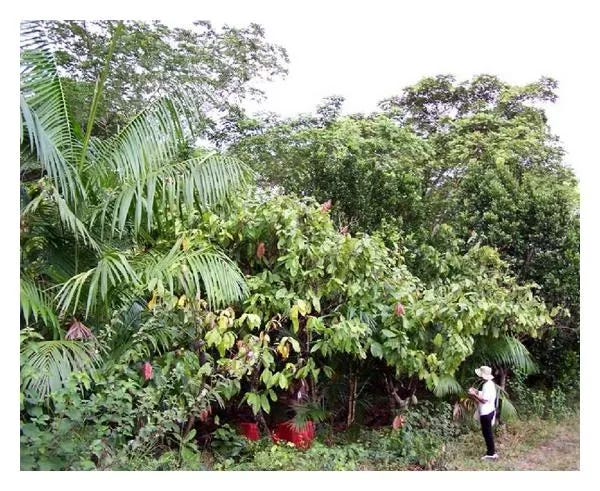From the Archives: Sri Lankan tree farms help native birds
These farms set up a buffer zone around a preserved forest
Although I started writing a Green Dispatch for today, I got distracted and was disappointed with the results. I figured that it was better to revisit a previous posting that is interesting rather than put out something new that wasn’t properly researched or well thought out.
A big hello and thank you to all the new subscribers. I hope you get something out of The Green Dispatch, as have the folks who’ve followed this publication for the last three years. Please, please feel free to comment and share your thoughts. I’d love to hear from you.
This post is a reprint from March 2021.
Tree Farms Help Sri Lankan Birds
Amid the thickets of the forests of Sri Lanka, red-backed flamebacks flit their way up and down tree trunks. Bright red wings cover the woodpeckers like capes, while streaks of white and black reach up their necks to their Jurassic heads and large beaks.
Sri Lankan wood pigeons distinguish themselves with their dusky emerald wings and white crowns. Green-billed coucals occupy dense foliage, stalking insects and small vertebrates. Brilliant red-faced malkoas are followed everywhere by their long, white-tipped tails.
These are just a handful of the beautiful birds found only in Sri Lanka. And the birds are just part of the larger unique ecosystems found on the island. Sri Lanka is small, about the size of West Virginia, yet its varied terrain and climate, as well as the island’s isolation from the mainland, has led to this portion of South Asia becoming a hotspot of biodiversity.
Within the island, there are dramatic differences in topography and climate. The Central Highlands are known for their breathtaking terrain, home to sweeping valleys, vertiginous cliffs, and peaks that exceed 7000 feet. Pidurutalagala, Sri Lanka’s highest peak, towers at almost 8300 feet.
The highlands catch the rains that come off the Indian Ocean, with some parts of the mountains drenched by more than 150 inches of rain in a year. In the north, rainfall averages range from 30 to 70 inches annually, which is usually received during the monsoon season, from May through October. Many areas in the north experience annual droughts that can last for more than three months.
Since the 1930s, however, Sri Lanka has suffered environmentally, losing about 30 percent of its forest cover, a plight similar to much of South Asia. The destruction has taken its toll on the native birds. Of the 33 endemic or possibly endemic birds, 17 are listed as vulnerable, near threatened, or endangered.
A team of researchers from Yale University and the University of Sri Jayewardenapura in Sri Lanka looked into how a particular type of farming might help Sri Lanka’s birds.
The researchers looked at tree gardens, a traditional way of farming throughout southern Asia, and whether the gardens can be places for the birds to live and find food. These gardens, or as people with degrees call them, multistrata agroforests, use the natural design of a forest, with an overstory and understory, as an environment to grow food and other agricultural items. Crops are planted around trees, and the trees themselves may be part of the harvestable system, with coconut and other fruit-bearing trees being integrated into a garden. Often intermediate stories of shrubs are added as well.
Besides Sri Lanka, tree gardens are used throughout India, Indonesia, Vietnam, Thailand, and Malaysia, and the practice has also been adopted in Brazil. In Sri Lanka, tree gardens are everywhere, making up almost half of the forested areas and 14 percent of the island’s total land area. Though folks have farmed tree gardens for centuries, there is ongoing research into the farming practices.

The scientists looked at bird populations around Pitakele, a village of around 30 households that borders the Sinharaja rainforest. Designated as a Sri Lankan National Park, a UNESCO Man and the Biosphere Reserve, UNESCO World Heritage Site, and a Bird Life International Important Bird Area, the Sinharaja rainforest occupies about 35 square miles at the southern tip of Sri Lanka and is one of the only remaining stands of connected, relatively undisturbed lowland rainforest on the island.
In an effort to maintain the wildlife of the reserve, the Sri Lankan government has set up a buffer zone, consisting of reforested areas as well as small villages, like Pitakele, that are meant to have a harmonious existence with the forest. Residents harvest tea from relatively small plots and rely on agriculture from tree gardens.
The researchers surveyed the birds in tea plots, tree gardens, and forest fragments. They wound up sighting 1269 individual birds of 76 different species. They found 59 species in tree gardens, 48 in forest fragments, and 44 in the tea plots. The surveys showed that more birds, and more bird species, used tree gardens than forest fragments or tea plots in the study area. Tree gardens also had more endemic birds and birds of conservation concern. The team published its findings in Frontiers in Ecology and Evolution in February.



Wow